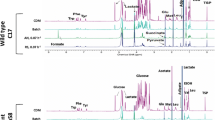Summary
While the ability of lactobacilli to catabolize pyruvate to a variety of industrially important catabolites is well known, the mechanisms which regulate pyruvate distribution among alternative catabolic pathways is unclear. This paper demonstrates that environmental acidity regulates the catabolic activities ofLactobacillus plantarum cells in chemostat cultures.L. plantarum cells grown in medium containing 100 mM exogenous pyruvate, diverted pyruvate away from lactate to acetoin. Pyruvate uptake and acetoin generation increased under acidic conditions; on a molar basis, pyruvate utilization increased twice as fast as acetoin production, reflecting the 2∶1 stoichiometry of pyruvate incorporation into acetoin. Lactate production increased under alkaline conditions when glucose was fermented to provide endogenous pyruvate. Acetate was formed only at pH 7.5 and 8.0, although acetoin production decreased at elevated pH values. These data indicate thatL. plantarum adjusts to changes in environmental pH by altering its distribution of pyruvate among various catabolites.
Similar content being viewed by others
References
Branen, A.L. and T.W. Keenan. 1970. Diacetyl, acetoin and 2.3-butanediol production byLactobacillus casei. J. Dairy Sci. 53:632.
Cogan, T.M., M. O'Dowd and D. Mellenick. 1981. Effect of pH and sugar on acetoin production from citrate byLeuconostoc cremoris. Appl. Environ. Microbiol. 41:1–8.
Cogan, T.M., R.J. Fitzgerald and S. Doonan. 1984. Acetolactate synthase ofLeuconostoc lactis and its regulation of acetion production. J. Dairy Res. 51:597–604.
Craig, J.A. and E.E. Snell. 1951 The comparative activities of pantethine, pantothenic acid and coenzyme A for various microorganisms. J. Bacteriol. 61:238–291.
de Cardenas, J.L.B., O.V. Ledesma and G. Oliver. 1987.Lactobacillus casei subsp.rhamnosus ATCC 7469. Current Microbiol. 15:259–264.
Dennis, D. and N.O. Kaplan. 1960.d-andl-lactic acid dehydrogenases inLactobacillus plantarum. J. Biol. Chem. 235: 810–818.
de Vries, W., W.M.C. Kapteyn, E.G. Van der Beek and Stouthamer. 1970. Molar growth yields and fermentation balances ofLactobacillus casei L3 in batch cultures and in continuous cultures. J. Gen. Microbiol. 63:333–345.
Doelle, W.H. 1971. Nicotinamide adenine dinucleotide-dependent and-independent lactate dehydrogenases in homofermentative and heterofermentative lactic acid bacteria. J. Bacteriol. 108:1284–1289.
El-Gendy, S.M., H. Abdel-Galil, Y. Shanin and F.Z. Heganzi. 1983. Acetoin and diacetyl production by homo-and heterofermentative lactic acid bacteria. J. Food Protect. 46: 420–425.
El-Gendy, S.M., H. Abdel-Gahil and F. Z. Hegazi. 1983. Acetoin and diacetyl production byLactobacillus plantarum able to use citrate. J. Food Protect. 46:503–505.
Fryer, F.F. 1970. Utilization of citrate by lactobacilli isolated from dairy products. J. Dairy Res. 37:9–11.
Garvie, E.I. 1980. Bacterial lactate dehydrogenases. Microbiol. Rev. 44:106–139.
Gunsalus, I.C. 1958. Energy metabolism of lactic acid bacteria. 4th Int. Cong. Biochem., Vienna 13:444.
Hensel R. U. Mayr, H. Fujiki and O. Kandler. 1977. Comparative studies of lactate dehydrogenases in lactic acid bacteria. Eur. J. Biochem. 880:83–92.
Hibbert, F., S.A. Kyrtopoulos and D.P.N. Satchell. 1971. Kinetic studies with phosphotransacetylase. Biochim. Biophys. Acta 242:39–54.
Hickey, M.W., A.J. Hillier and G.R. Jago. 1983. Metabolism of pyruvate and citrate in lactobacilli. Aust. J. Biol. Sci. 36: 487–496.
Ingraham, J.L., O. Maaloe and F.C. Nerdhadt. 1983. Polymerization, Biosynthesis, Fueling and Transport. Chapt. 3 In: Growth of the Bacterial Cell, pp. 136–150. Sinauer Associates, Inc., publishers. Sunderland, Mass.
Kandler, O. and N. Weiss, 1984. Regular, nonsporing, Gram-positive rods. Section 14 In:Bergey's Manual of Systematic Bacteriology, Vol. 2. (P.H.A. Sneath, ed.), Williams and Wilkens, Baltimore, MD.
Koch, A.L. 1981. Growth measurement. Ch. 11. In: (P. Gerhardt, R.G.E. Murray, R.N. Costilov, W.E. Nester, W.A. Wood, N.R. Krieg and G.B. Phillips eds.), Manual of Methods for General Bacteriology, p. 196. ASM. Washington, DC.
Lindmark D.G., P. Paolella and N.P. Wood, 1969. The pyruvate formate-lyase system ofStreptococci faecalis. J. Biol. Chem. 244:3605–3612.
Mizushima, S. and K. Kitahara. 1962 Purification and properties of lactic dehydration ofLactobacillus casei. J. Gen. App. Microbiol. 8:130–141.
Montville, T.J., M.E. Meyer and A.M.H. Hsu. 1987. Influence of carbon substrate on lactic acid, cell mass and diacetylacetoin production inLactobacillus plantarum. J. Food Protect. 50:42–46.
Montville, T.J., A.H.M. Hsu and M.E. Meyer. 1987. Highefficiency of pyruvate to acetoin byLactobacillus plantarum during pH-controlled and fed-batch fermentations. Appl. Environ. Microbiol. 53:1798–1802.
Montville, T.J. 1987. Continuous culture: theory and applications. In: (Montville, T.J., ed.), Food Microbiology Vol. 2: New and Emerging Technologies. p. 165–186, CRC Press, Boca Raton, GL.
Montville, T.J., A.H.M. Hsu, M.E. Meyer and G.T.C. Huang. 1987. High pressure liquid chromatography and wide-bore capillary gas chromatography methods for acetoin and diacetyl. J. Microbiol. Meth. 7:1–8.
Otto, R., B. ten Brinks, H. Veldkamp and W.N. Konings, 1983. The relation between growth rate and electrochemical proton gradient ofStreptococci cremoris. FEMS Microbiol. Lett. 16:69–74.
Rhee, S.K. and M.Y. Pack. 1980. Effect of environmental pH on fermentation balance ofLactobacillus bulgaricus. J. Bacteriol. 144:217–221.
Satchell, D.P.N. and G.F. White. 1970. Kinetic studies with acetate kinase. Biochim. Biophys. Acta 212:248–256.
Smart, J.B. and T.D. Thomas. 1987. Effect of oxygen on lactose metabolism in lactic streptococci. App. Environ. Microbiol. 53:533–541.
ten Brinks, B. and W.N. Konings. 1982. Electrochemical proton gradient and lactate concentration gradient inStreptocossus cremoris cells grown in batch culture. J. Bacteriol. 152: 682–686.
ten Brinks, B., R. Otto, U.P. Hansen and W.N. Konings, 1985. Energy recycling by lactate efflux in growing and nongrowing cells ofStreptococci cremoris. J. Bacteriol. 162:383–390.
Thomas, T.D., D.C. Ellwood and U.M.C. Longyear. 1979. Change from homo-to heterofermentation byStreptococcus lactis resulting from glucose limitation in anaerobic chemostat cultures. J. Bacteriol. 138:109–117.
Thomas, T.D. and K.W. Turner. 1981. Carbohydrate fermentation byStreptococcus cremoris andStreptococcus lactis growing in agar gels. Appl. Environ. Microbiol. 41:1289–1294.
Author information
Authors and Affiliations
Rights and permissions
About this article
Cite this article
McFall, S.M., Montville, T.J. pH-mediated regulation of pyruvate catabolism inLactobacillus plantarum chemostat cultures. Journal of Industrial Microbiology 4, 335–340 (1989). https://doi.org/10.1007/BF01569535
Received:
Revised:
Accepted:
Issue Date:
DOI: https://doi.org/10.1007/BF01569535




